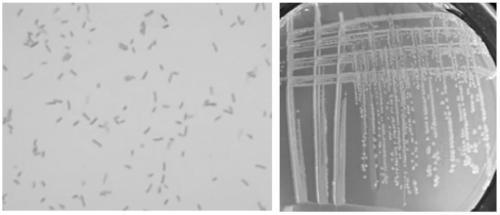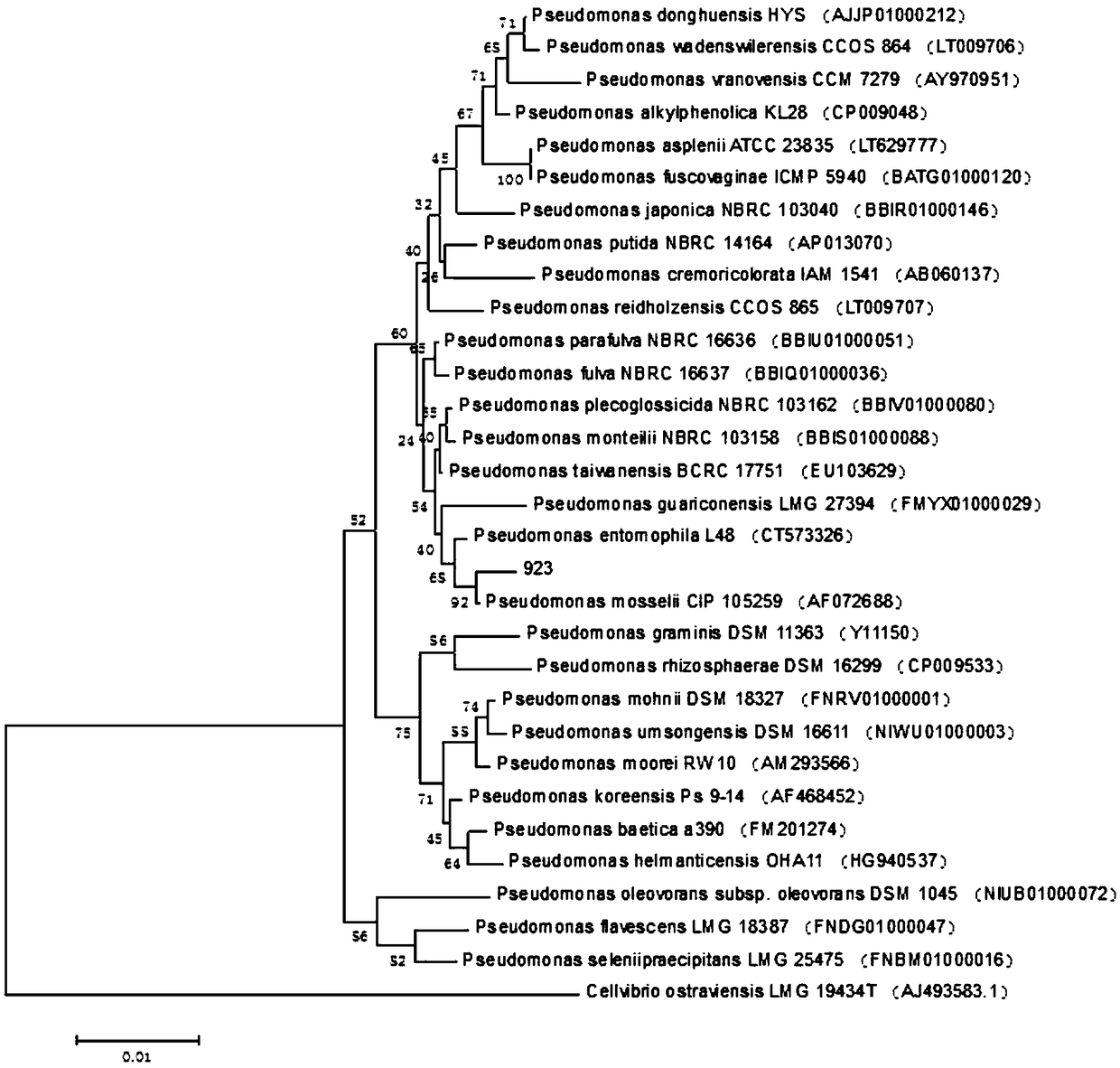Pseudomonas having antagonistic action against Xanthomonas oryzae and magnaporthe oryzae and application of pseudomonas
A technology of Pseudomonas and rice stripe bacteria, applied in the field of microorganisms, to achieve broad-spectrum antibacterial ability and strong inhibitory effect
- Summary
- Abstract
- Description
- Claims
- Application Information
AI Technical Summary
Problems solved by technology
Method used
Image
Examples
Embodiment 1
[0040] Isolation, screening and purification of embodiment 1 Pseudomonas 923
[0041] The experimental steps are as follows:
[0042] 1. Soil source
[0043] Rhizosphere soil of unharvested paddy fields in Fengxian District, Shanghai
[0044] 2. Acquisition of strains
[0045] (1) Soil sample collection
[0046] Zig-shaped 5-point sampling method for soil sample collection: collect 200g soil samples at each point, mix the soil samples at 5 points taken according to the Z-shape evenly, take 200g by quartering method and put them into a sterilization bag as a soil sample . Three soil samples were collected from each plot as replicates. Record the time, place and type of sampling. The collected soil samples were stored in a refrigerator at 4°C for bacterial screening.
[0047] (2) Isolation of strains
[0048] Plate dilution method: Weigh 10g of each soil sample into a sterile conical conical flask, add 90mL of sterile water, then place at 200rpm, shake in a shaker at 28°...
Embodiment 2
[0053] The 16S rRNA gene identification of embodiment 2 Pseudomonas 923
[0054] Extract the genomic DNA of Pseudomonas 923, use it as a PCR template, use 27F 5'-AGAGTTTGATCCTGGCTCAG-3' and 1492R 5'-TACGGCTACCTTGTTACGACTT-3' as primers; Said reagent, carry out PCR reaction:
[0055] Table 1 Taq polymerase chain reaction system
[0056]
[0057] The basic conditions of the PCR reaction were: pre-denaturation at 94°C for 3 min, denaturation at 94°C for 30 s, annealing at 56°C for 30 s, extension at 72°C for 90 s (1 kb / min), pre-extension at 72°C for 8 min, and storage at 4°C for a total of 30 cycles. After the reaction, the PCR products were checked by 1% agarose gel electrophoresis, and the gel imager was used to detect and record the results (see attached image 3 ). Send the PCR stock solution to Bosun Biotechnology (Shanghai) Co., Ltd. for sequencing. The sequencing results were analyzed using DNA Star and compared with BLAST on the NCBI website to determine the speci...
Embodiment 3
[0059] Physiological and biochemical identification of embodiment 3 Pseudomonas mosei 923
[0060] The physiological and biochemical characteristics of Pseudomonas mosei 923 of the present invention are: it can produce fluorescent pigment, can secrete arginine dihydrolase and protease, can not hydrolyze urease and β-galactosidase; can assimilate glucose, mannose, Mannitol, N-acetyl-glucosamine and phenylacetic acid, cannot assimilate arabinose, maltose, gluconate, capric acid, adipic acid, malic acid, citric acid; can utilize dextrin, Tween 40, L-arabinose , D-fructose, α-D-glucose, D-mannitol and other 53 carbon sources, see Table 2 and Table 3.
[0061] Table 2 Physiological and biochemical characteristics of strain 923 - enzyme activity, carbon source assimilation
[0062]
[0063]
[0064] +: Positive reaction; -: Negative reaction;
[0065] Table 3 Physiological and biochemical characteristics of strain 923—acid production using carbon source
[0066]
[0067]...
PUM
| Property | Measurement | Unit |
|---|---|---|
| diameter | aaaaa | aaaaa |
Abstract
Description
Claims
Application Information
 Login to View More
Login to View More - R&D
- Intellectual Property
- Life Sciences
- Materials
- Tech Scout
- Unparalleled Data Quality
- Higher Quality Content
- 60% Fewer Hallucinations
Browse by: Latest US Patents, China's latest patents, Technical Efficacy Thesaurus, Application Domain, Technology Topic, Popular Technical Reports.
© 2025 PatSnap. All rights reserved.Legal|Privacy policy|Modern Slavery Act Transparency Statement|Sitemap|About US| Contact US: help@patsnap.com



